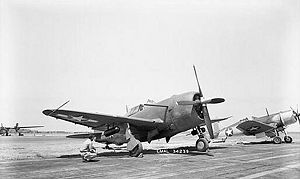P-47 Thunderbolt
The P-47 fighter plane, nicknamed the Thunderbolt was the workhorse tactical airplane of the US Army Air Forces in World War II. In a frantic technological race against the Nazis, American designers created a series of fighters and bombers that had the speed, climb-rate, maneuverability, and range to do the job.
Origins
The P-47 originated in 1940, when AAF commander General Hap Arnold asked for a plane to give air superiority over the Germans. Alexander Kartveli, chief designer at Republic Aviation, met the challenge using an unusually large fuselage and the new 18 cylinder, 2,000 horsepower air-cooled radial "Double Wasp" engine from Pratt and Whitney. Its high-altitude performance was dramatically enhanced by a General Electric turbo-supercharger.[1]
Weapon system
Production model #1 flew in spring 1942 and #10,000 flew in fall 1944. The plane, produced by Republic Aviation, cost an average of $80,000 (compared to $50,000 for the smaller P-51). The 1945 version P-47M, burning 115/145 grade gasoline, had a maximum speed of 460 mph, a ceiling of 40,000 feet, and (with auxiliary drop tanks) a combat range of 2,000 miles. Escorting the B-17 and the B-29, its 8 50-caliber machine guns could rip apart Luftwaffe or Japanese fighters (which had only 90 octane gasoline). As a tactical weapon it was armed with five 500 pound bombs plus ten 5" rockets. At ten tons, the big Thunderbolt needed a long runway, and was less agile than the Luftwaffe's Focke-Wolf 190. But it was better than good enough, downing 3 German planes for every loss.
Tactical air support
The main missions of the P-47 were tactical air support for ground combat, and (until the P-51 came on line), defending strategic bombers from Luftwaffe fighters. Although its loss rate was only 7 per 1,000 sorties, these tactical workhorses were sent out so often that half were shot down, chiefly by flak guns.
Infantrymen were ecstatic about the effectiveness of close air support:
- Air strikes on the way; we watch from a top window as P-47s dip in and out of clouds through suddenly erupting strings of Christmas-tree lights [flak], before one speck turns over and drops toward earth in the damnest sight of the Second World War, the dive-bomber attack, the speck snarling, screaming, dropping faster than a stone until it's clearly doomed to smash into the earth, then, past the limits of belief, an impossible flattening beyond houses and trees, an upward arch that makes the eyes hurt, and, as the speck hurtles away, WHOOM, the earth erupts five hundred feet up in swirling black smoke. More specks snarl, dive, scream, two squadrons, eight of them, leaving congealing, combining, whirling pillars of black smoke, lifting trees, houses, vehicles, and, we devoutly hope, bits of Germans. We yell and pound each other's backs. Gods from the clouds; this is how you do it! You don't attack painfully across frozen plains, you simply drop in on the enemy and blow them out of existence.[2]
Escort role
The slower, shorter-range P-47 was already escorting bombers part of the way into Germany; in a reversal of roles, that mission in January 1944 went to the P-51 Mustang while the P-47 was re assigned to tactical targets on the ground. The Thunderbolt's air-cooled engine was less vulnerable to ground flak; one bullet hole in the plumbing of a Mustanng's water-cooled engine would drain off the coolant and crash the P-51.
Impact
Thunderbolt groups claimed the destruction of 6,000 tanks and armored fighting vehicles, 9,000 locomotives, 86,000 items of rolling stock, 68,000 trucks, and huge numbers of enemy troops killed or wounded. According to air power historian W. A. Jacobs, "All authorities agreed that the P-47 was the best fighter-bomber."[3]
References
- ↑ The turbo-supercharger compressed exhaust air and returned it to the carburetors. GE, at work on the device since 1918, finally solved the extremely difficult problems of very high 11 speed rotation at high temperatures.
- ↑ Brendan Phibbs, The Other Side of Time: A Combat Surgeon in World War II (1987) entry for Jan. 21, 1945 p 149
- ↑ W. A. Jacobs, "The Battle for France, 1944," in B. Franklin Cooling, Case Studies in the Development of Close Air Support (1990), p. 250.
